英语课程与教学论_Unit Two Communicative Language Tea
《英语教学法》Unit 2 Communicative Principles and TBLT
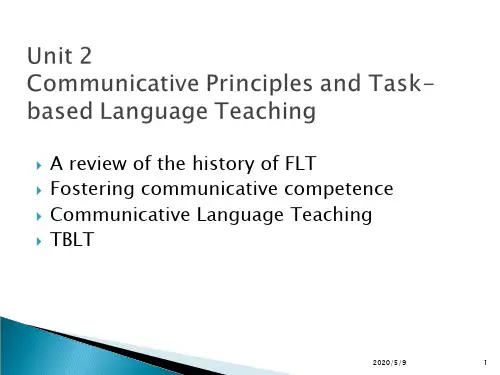
2017/2/16
2
The Grammar-translation method
Traditional method / classical method; uses translation and grammar study as the main teaching and learning activities; a reflection of the way Latin and Greek were taught; to help Ss read and appreciate foreign language literature; seen as an academic study focus on grammatical rules, the memorization of vocabulary, the inflection of words, translations of texts, doing written exercises.
The Disadvantages of Direct method:
1.
2.
3.
The absolute avoidance of the native tongue occasionally troubles the Direct Method in teaching the meaning of abstract concepts. Without explicit grammar explanation, students lack a necessary knowledge of the target language. The Direct Method places a high demand on the teacher.
Unit_2_Communica...
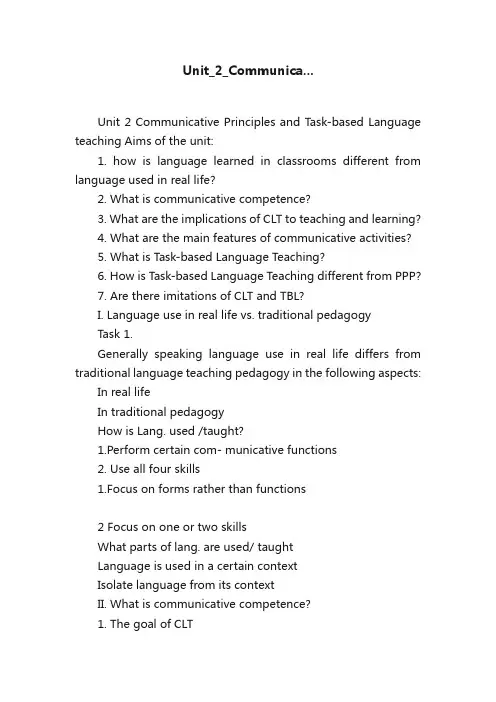
Unit_2_Communica...Unit 2 Communicative Principles and Task-based Language teaching Aims of the unit:1. how is language learned in classrooms different from language used in real life?2. What is communicative competence?3. What are the implications of CLT to teaching and learning?4. What are the main features of communicative activities?5. What is Task-based Language Teaching?6. How is Task-based Language Teaching different from PPP?7. Are there imitations of CLT and TBL?I. Language use in real life vs. traditional pedagogyTask 1.Generally speaking language use in real life differs from traditional language teaching pedagogy in the following aspects: In real lifeIn traditional pedagogyHow is Lang. used /taught?1.Perform certain com- municative functions2. Use all four skills1.Focus on forms rather than functions2 Focus on one or two skillsWhat parts of lang. are used/ taughtLanguage is used in a certain contextIsolate language from its contextII. What is communicative competence?1. The goal of CLTThe goal of CLT is to develop students’ communicative competence, which includes both the knowledge about the language and the knowledge about how to use the language appropriately in communicative situations.Task 2:“Why don’t you close the door?”—a real question, a command or a complaint?Task 4:Discuss the possible meaning and function each may have.l Flight CA 937 is now landing.l The train is leaving in ten minutes.l She is always complaining whenever you talk to her.l He is making progress slowlyFrom the above tasks we can see that one language form may express a number of communicative functions and one communicative function can also be expressed by a variety of language forms.2. Five main components of communicative competence.Hedge discusses five main components of communicative competence: linguistic competence, pragmatic competence, discourse competence, strategic competence and fluency.(1) Linguis tic compe tence: “is concerned with knowledge of the language itself, its form and meaning”(Hedge, 2000)(2) Pragmatic competence: is concerned with the appropriate use of the language in social context.(3) Discourse competence: refers to one’s ability to create coherent written text or conversation and the ability to understandthem.(Canale and Swain, 1980)(4) Strategic competence: similar to communicationstrategies. It refers to strategies one employs when there is communication breakdown due to lack of resources.(5) Fluency: one’s ability to “link units of speck together with facility and without strain or inappropriate slowness or undue hesitation”(Hedge)3. Language competence and communicative competence(1) Chomsky’s theory: competence simply mea ns knowledge of the language system: grammatical knowledge in other words(2) Hymes’s theory: “there are “rules of use without which the rules of grammar would be useless”. Besides grammatical rules, language use is governed by rules of use, which ensure that the desired or intended functions are performed and the language used is appropriate to the context.(3) Communicative competence: according to Hymes, communicative competence means people should know “what to sa y to whom and how to say it appropriately in any given situation”, which includes four aspects: . grammatically acceptable. understandable. social norms. actually use4. Implications for teaching and learningTask 5:Communicative competenceImplications for language teaching(Teachers need to help learners)Linguistic competencel Achieve accuracy in the grammatical forms of the languages; l Pronounce the forms accurately;l Use stress, rhythm and intonation to express meaning;l Build a range of vocabulary;l Learn the script and spelling rules.l Achieve accuracy in syntax and word formation.Pragmatic competencel Learn the relationship between grammatical forms and functions;l Use stress and intonation to express attitude and emotion;l Learn the scale of formality;l Understand and use emotive tone;l Use the pragmatic rules of language.l Select language forms appropriate to topic, listener or setting, etc.Discourse competencel Take longer turns, use discourse markers and open and close conversations;l Appreciate and be able to produce contextualized written texts in a variety of genres;l Be able to use cohesive devices in reading and writing texts;l Be able to cope with authentic texts.Strategic competencel To take risks in using the language;l To use a range of communicative strategies;l To learn the language needed to engage in some of these strategies.Fluencyl Deal with the information gap of real discourse;l Process language and respond appropriately with a degree of ease;l Be able to respond with reasonable speed i n “real time”.III. Principles of Communicative Language Teaching1. Principles of CLT:l Communicative principle: Activities that involve real communication promote learning.l Task principle: Activities in which language is used for carrying out meaningful tasks promote learning.l Meaningfulness principle: language that is meaningful to the learner supports the learning process.2. Features of CLTl authentic and creativel meaning rather than forml relevant to the needsl task-based teachingl functional approach3. The implementation of language skills(1) In listening and speaking, students should have the chance to listen to and produce what is meaningful, authentic, unpredictable, and reactive if ever possible.(2) In reading. Since communicative courses focus on meaning rather than on form, the reading skill is redefined to focus on the purpose ofreading.(3) In writing, students should make the writing more meaningful and authentic, that is to practice writing to express their own feelings or describe their own experience.4. Communicative activities.(1) MMC system. Mechanic drills, meaningful drills and communicative drills. / Functional communicative activities, and Asocial interaction activities,(P. 22)(2) Six criteria for evaluating communicative classroomactivities:i. communicative purposeii. communicative desireiii. content, not formiv. variety of languagev. no teacher interventionvi. no materials controlIV. Task-based Language Teaching (TBLT)1. Definition of a task:l [a task] is a piece of work undertaken for oneself or for others, freely or for some reward. Thus, examples of tasks include painting afence, dressing a child, filling out a form, buying a pair of shoes, making an airline reservation, borrowing a library book, takin g a driving test, typing a letter…In other words, by “task” is meant the hundred and one things people do in everyday life, at work, at play, and in between. (Long 1985)l …a piece of classroom work which involves learners in comprehending, manipulating, producing or interacting in the target language while their attention is principally focused on meaning rather than form.(Nunan 1989)l Tasks are activities where the target language is used by the leaner for a communicative purpose (goal) in order to achieve an outcome.(Wills 1996)l A task is essentially goal-oriented; it requires the group, or pair, to achieve an objective that is usually expressed by an observable result, such as brief notes or lists, rearrangement of jumbled items, a drawing, a spoken summary. This result should be stainable only by interaction between participants: so within the definition of the task you often find instructions such a s“reach a consensus” or “find out everyone’s opinions”. (Ur 1996)2. Four components of a task:l A purpose: making sure the students have a reason for undertaking the task.l A context: the task can be real, simulated or imaginary, and involves sociolinguistic issues, such as the location, the participants and other important factors.l A process: getting the students to use learning strategies such as problem solving reasoning, inquiring, conceptualizing and communicating.l A product: there will be some form of outcome, either visible (a written plan, a play, a letter. etc.) or invisible (enjoying a story, learning about another country, etc.)3. Exercises, exercise-task and tasksl Exercises: focus on individual language itemsl Tasks: Purposeful and contextualized communicationl Exercise-task: halfway between tasks and exercises.Task 10.Activity 1: This activity has all the characteristics of a task.l The workplan specifies what the two participants in the task are supposed to do.l The primary focus is on meaning.l Student A has to talk about the dangerous moment and student B is free to ask questions to clarify. The language use is similar to a natural communicative event.l The outcome of this task is the completion of a picture by student B.Activity 2: This activity is an exercise-task.l This is an example of a cue-card activity. It has some of thefeatures of a task. For example, it requires participants to interact orally and the participants are free to choose the linguistics resources.l However, the primary focus is on form because the meanings are predetermined. Also, there isn’t a clear communicative outcome.l The outcome is the performance of the activity. Therefore, the purpose of this activity is to practice language.Activity 3: This is obviously an exercise.l They primary focus is on form—the use of “any and “some” in questions and replies learners simply need to substitute items.l The language use is by no means like the real-world communication.Activity 4: This is an exercise-task.l Telling a story from pictures where every student can see what is happening in each picture is not a task.l It is simply a language practice activity—what communicative purpose is there?l If there were two sets of pictures, and one group prepared a story based on their set of pictures and told it to a group who then had to arrange that set of pictures in the right order, this would create a communicative purpose, and therefore a need to listen. The latter would be a good task—initially with the teacher telling the story and the learners at tables arranging the pictures.4. PPP and Task-based Language Teaching(1) PPP teaching model: Presentation, Practice, Production(2) The difference between PPP and TBLT(see Figure 2.2 and 2.3 on P. 31 & 32)Figure 2.2 TBLFigure 2.3 PPPl The way students use and experience language in TBL, is radically different from PPP.l TBL can provide a context for grammar teaching and form-focuses activities. PPP is different in this aspect. (P.32)5. How to design tasks?(1) Question that should be considered before design tasks. l What is the objective of the taskl What is the content of the task?l How is the task to be carried out?l In what situation is the task to be carried out?(2) The steps in designing tasks.Sept 1: Think about students’ needs, interests, and abilities. Step 2: Brainstorm possible tasks.Step 3: Evaluate the listStep 4: Choose the language items.Step 5: Preparing materials。
高职《英语教学论》课程标准
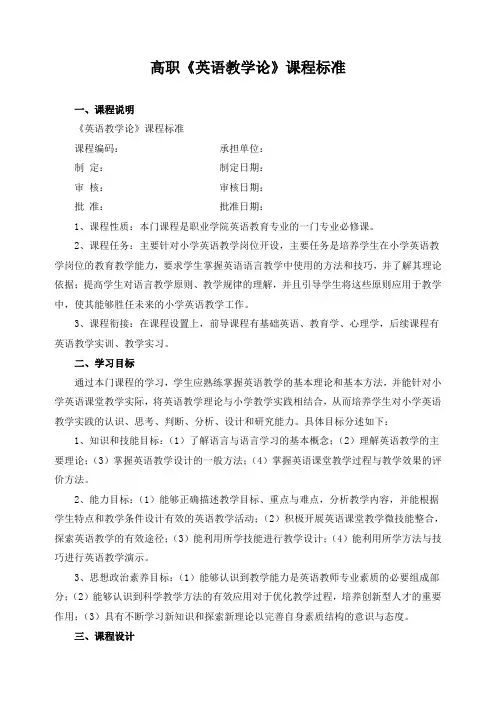
高职《英语教学论》课程标准一、课程说明《英语教学论》课程标准课程编码:承担单位:制定:制定日期:审核:审核日期:批准:批准日期:1、课程性质:本门课程是职业学院英语教育专业的一门专业必修课。
2、课程任务:主要针对小学英语教学岗位开设,主要任务是培养学生在小学英语教学岗位的教育教学能力,要求学生掌握英语语言教学中使用的方法和技巧,并了解其理论依据;提高学生对语言教学原则、教学规律的理解,并且引导学生将这些原则应用于教学中,使其能够胜任未来的小学英语教学工作。
3、课程衔接:在课程设置上,前导课程有基础英语、教育学、心理学,后续课程有英语教学实训、教学实习。
二、学习目标通过本门课程的学习,学生应熟练掌握英语教学的基本理论和基本方法,并能针对小学英语课堂教学实际,将英语教学理论与小学教学实践相结合,从而培养学生对小学英语教学实践的认识、思考、判断、分析、设计和研究能力。
具体目标分述如下:1、知识和技能目标:(1)了解语言与语言学习的基本概念;(2)理解英语教学的主要理论;(3)掌握英语教学设计的一般方法;(4)掌握英语课堂教学过程与教学效果的评价方法。
2、能力目标:(1)能够正确描述教学目标、重点与难点,分析教学内容,并能根据学生特点和教学条件设计有效的英语教学活动;(2)积极开展英语课堂教学微技能整合,探索英语教学的有效途径;(3)能利用所学技能进行教学设计;(4)能利用所学方法与技巧进行英语教学演示。
3、思想政治素养目标:(1)能够认识到教学能力是英语教师专业素质的必要组成部分;(2)能够认识到科学教学方法的有效应用对于优化教学过程,培养创新型人才的重要作用;(3)具有不断学习新知识和探索新理论以完善自身素质结构的意识与态度。
三、课程设计本课程以职业能力目标为载体,根据小学英语教学岗位工作任务要求,确定学习目标及学习任务内容;本课程采取行动导向项目教学教学模式,以学生为主体、以培养学生课堂教学能力为导向组织教学考核。
英语课程教学论Unit Two
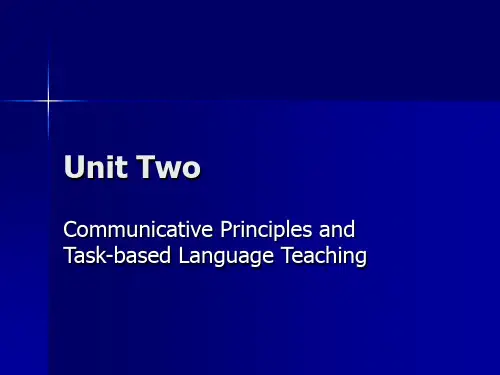
Principles of CLT(P20)
communication principle task principle meaningfulness principle
The weak version of CLT: learners first learn the language as a structural system and then learn how to use it in communication
PPP (P31-32)
Presentation (of single new item) Practice (of new item: drills,
exercises, dialogue) Production ( Activity, role play or task
to encourage free use of language)
The five-step teaching method
Revision Presentation Practice production consolidation
TBLT/TBL (P31)
Task-based Language Teaching (TBLT) Task-based Learning (TBL) Pre-task: introduction to topic and task Task cycle: task/planning/report;
Fluens of speech together with fluency and without nervousness or inappropriate slowness or undue hesitation
Unit2-Communicative-Principles-and-TBLT-英语教学法
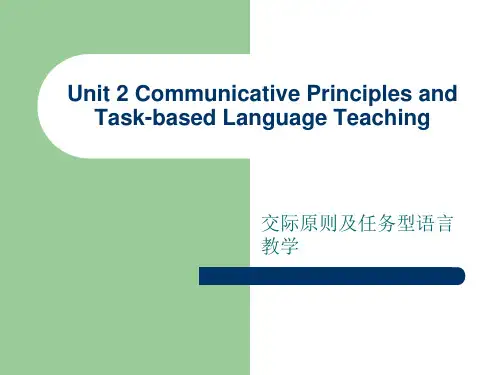
·build a range of vocabulary; ·Learn the script and spelling rules; ·achieve accuracy in syntax and word formation
Communicativ Implication for language teaching e competence
Unit 2 Communicative Principles and Task-based Language Teaching
交际原则及任务型语言 教学
Teaching Aims:
To discuss one of the most important trends in second/ foreign language teaching in the past three decades, that is the practice of communicative language teaching
Communicativ e competence
Discourse competence
Implication for language teaching
Teachers need to help learners take longer turns, use discourse marders
and open and close conversations; appreciate and be able to produce
contextualised written texts in a variety of genres;
be able to use cohesive devices in reading and writing texts;
英语教学法之communicative method
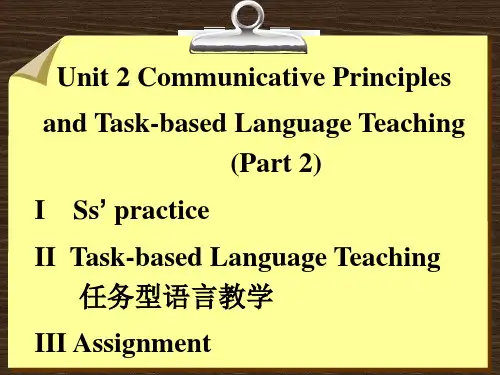
P26
2.2 Definition of task P27
学习者应用目的语所进行的促进语言学习 的,涉及信息理解、加工,或解决问题、 决策问题的一组相互关联的、具有目标指 向的课堂交际或互动活动。
2.3 Differences between exercise and task • Tasks do not include activities which involve language used for practice or display
2.4 Definition of TBLT
Task-based Language Teaching (TBLT) refers to an approach based on the use of tasks as the core unit of instruction in language.
(Part 2) I Ss’ practice II Task-based Language Teaching
任务型语言教学
III Assignment
2.1 What is the relationship between TBLT and CLT?
• further development • same beliefs: language should be
2.5 Features of TBLT
1. An emphasis on learning to communicate through interaction in the target language. 强调通过用目标语交流来学会交际
英语教学法教程Unit__2_Communicative_Principles__TBLT学习教案
The traditional FLT:
tends to isolate language from its context. e.g. the passive voice
The consequence:The students are puzzled about how to use the language in a p第a6页r/共t4i8页cular context.
2任务链任务链tasktaskcyclecycle由做任务学生分步骤执行任务由做任务学生分步骤执行任务计划就如何报告任务的结果做准备工作计划就如何报告任务的结果做准备工作以及以及yj报报告学生代表汇报任务完成情况告学生代表汇报任务完成情况三个环节组成三个环节组成3语言焦点语言焦点languagefocuslanguagefocus也叫语言分析在教师的引也叫语言分析在教师的引导下做以语言为焦点的活动如找与话题相关的单词导下做以语言为焦点的活动如找与话题相关的单词短语句型等
Communicative Competence includes knowledge of what to say, when , how, where and to say
第9页/共48页
第十页,共48页。
Five main components of communicative competence
第七页,共48页。
Conclusions
The language we teach in traditional FLT is not what we use in real-life communication.
The final goal of FLT : to enable the learners to use the foreign language in work or life. we should teach: that part of the language that will be used; in the way that 第7页/共48页 is used in the real world.
Unit 2 12.4 p1 Communicative Language Teaching(2012)
context
always used in a certain context.
isolate language from its context.
Does he have parents?
EG: 一头老黄牛坐在树梢上 咪咪叫
puzzled about how to use the language
1. Do some revision
Views on language
– Structural view (sound, words and sentences) – Functional view (as a linguistic system and as a means for doing things) – Interactional view (Rules of language form __grammar & vocabulary) ( Rules of language use in a context __语用)
1: Language use in real life v.s. traditional pedagogy
That is a way of the traditional language teaching. what about the language used in real life? • Supose when xiao li meet a foreigner in real life and says the santence to him : Have you had your lunch? For Chinese, Li means a question: ask if the foreigner has eaten the meal or not. it’s a usual informal greeting, and it has the same function as “Hello”. • But for English, it often means an invitation “Come, it’s my treat “ • the foreigner will feel confused why xiaoli asked me such a personal question? Why he moved away without waiting for the answer.
Unit 2 Communicative Language Teaching
What is the traditional teaching pedagogy like?
♪ The traditional teaching steps: ♪ Step 1: Teacher: Read the sentence, and then get the students to read the sentence after the teacher; ♪ Step 2: Teacher: Explain the meaning and translate the sentence from English into Chinese; ♪ Step 3: Teacher: Explain the grammatical grammatical structure or rules and tell the students to remember the tense in the sentence, ―the present perfect tense‖ and the formation of this tense ―have + P.P‖; ♪ Step 4: Teacher: give more examples, such as ―Have you had your breakfast?‖ Answer: Yes, I have. / No, I haven‘t. ♪ Step 5: Students: do pattern drills—read the examples again and again; ♪ Step 6: Students: Do some written exercises.
What is language use in real life like? ♪ But when two Chinese people meet in real life, Xiao Li says to Lao Wang, “Have you had your lunch?”
Unit2 Communicative Principles and TBLT 英语教学法
Communicative competence
Implication for language teaching
Strategic competence
Teachers need to enabl learners to take risks in using the language; to use a range of communicative strategies; to learn the language needed to engage in some these;
Communicative competence fluency
Part 1.3 Implication for teaching and learning (Refer to p.19 (textbook)
Communicative Implication for language teaching competence Teachers need to help learners Linguistic competence · achiever accuracy in the grammatical forms
2.Teaching Content:
Language use in real life vs. traditional pedagogy Fosterie implementation of language skills Communicative activities Conclusion: How do we learn language?
Communicative competence is a term in linguistics which refers to a language user‘s grammatical knowledge of syntax(句法), morphology(构词), phonology(音位) and the like, as well as social knowledge about how and when to use utterances appropriately. The term was coined by Dell Hymes in 1966,reacting against the perceived inadequacy of Noam Chomsky‘s (1965) distinction between competence and performance.To address Chomsky’s abstract notion of competence, Hymes undertook ethnographic exploration of communicative competence that included “communicative form and function in integral relation to each other” (Leung, 2005).[3] The approach pioneered by Hymes is now known as the ethnography of communication.(交际人种志)
- 1、下载文档前请自行甄别文档内容的完整性,平台不提供额外的编辑、内容补充、找答案等附加服务。
- 2、"仅部分预览"的文档,不可在线预览部分如存在完整性等问题,可反馈申请退款(可完整预览的文档不适用该条件!)。
- 3、如文档侵犯您的权益,请联系客服反馈,我们会尽快为您处理(人工客服工作时间:9:00-18:30)。
Five components of communicative competence
• Strategic competence: strategies one employs when there is communication breakdown due to lack of resources.
2.1 What is communicative competence?
At the end of this class, you will be able to have a better understanding about communicative competence and its implication for teaching and learning English.
• Pragmatic competence
Teachers need to help learners ☻ learn the relationship between grammatical forms and functions; ☻ use stress and intonation to express attitude and emotion; ☻ learn the scale of formality; ☻ understand and use emotive tone; ☻ use the pragmatic rules of language. ☻ select language forms appropriate to topic, listener or setting, etc.
Unit Two Communicative Language Teaching (1)
Aims for Unit Two
At the end of the unit, you will be able : • to know what communicative competence is; • to understand implications for teaching and learning; • to know principles of Communicative Language Teaching; • to comprehend CLT and the teaching of language skills; • to understand main features of communicative activities; • to grasp criteria for evaluating communicative activities.
• Fluency: one’s ability to “link units of speck together with facility and without strain or inappropriate slowness or undue hesitation”.
• Linguistic competence
Thewayof acquiring/ learning
•Learningthrough
•Languageistaughtby
immerging,experimenting, ive competence includes • the knowledge about the language • and the knowledge about how to use the language
Language used in real life vs. traditional pedagogy
Inreallife
traditionalpedagogy
•Performingcertain HowisLang. communicativefunctions used/taught? •Usingallfourskills
Teachers need to help learners ☻ achieve accuracy in the grammatical forms of the languages; ☻ pronounce the forms accurately; ☻ use stress, rhythm and intonation to express meaning; ☻ build a range of vocabulary; ☻ learn the script and spelling rules; ☻ achieve accuracy in syntax and word formation.
Whatpartsof •Languageisusedina languageare certaincontext used/taught?
•Focusingonformsrather thanfunctions •Focusingononeortwo skills
•Isolatinglanguagefrom itscontext
appropriately in communicative situations.
Five components of communicative competence
• Linguistic competence: “concerned with knowledge of the language itself, its form and meaning”(Hedge, 2000). • Pragmatic competence: concerned with the appropriate use of the language in social context. • Discourse competence: one’s ability to create coherent written text or conversation and the ability to understand them (Canale and Swain, 1980).
